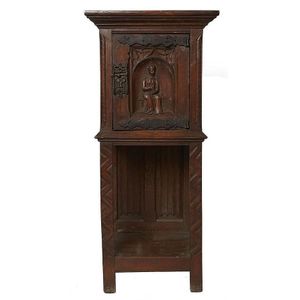Limed Gothic Oak Court Cabinet, Late 19th Century
You must be a subscriber, and be logged in to view price and dealer details.
Subscribe Now to view actual auction price for this item
When you subscribe, you have the option of setting the currency in which to display prices to $Au, $US, $NZ or Stg.
- Provenance - A term used to describe the provable history of an antique or work of art, and thus an additional aid to verifying its authenticity. Provenance can have an inflating effect on the price of an item, particularly if the provenance relates to the early settlement of Australia, a famous person, or royalty. Less significant are previous sales of the item through an auction house or dealer.
- Gothic Style, Furniture - Gothic style furniture refers to pieces that are designed and crafted in the Gothic architectural and decorative style that was popular in Europe from the 12th to the 16th centuries. This style of furniture is characterised by its elaborate and ornate details, as well as its use of dark and heavy woods, such as oak and walnut.
Gothic style furniture often features intricate carvings and embellishments, including pointed arches, quatrefoils, and tracery. The style also frequently incorporates elements such as coats of arms, shields, and religious symbols. Gothic furniture often has a heavy and substantial appearance, and the pieces are often finished with a dark stain to accentuate the detailed carving and embellishments.
The furniture items can be quite large and imposing, and they are often used as statement pieces in large rooms. Gothic furniture can be a striking and dramatic addition to any space, and it is often appreciated by those who have an interest in medieval and historical design. - Limed / Cerused Finish - A process for finishing timber whereby the surface was covered with a coating of lime, which was subsequently brushed from the surface, but allowed to remain in the grain. The resulting surface with its streaking and speckling of white was usually left unpolished. The finish was popular for French furniture in the late 19th century, and English cottage style furniture in the early 20th century. Oak timber was popular for liming because its open grain retained a larger amount of the lime than other close grained timbers.
Nowadays the same effect can be achieved by use of paint, or proprietry solutions for "liming". - Oak - Native to Europe and England, oak has been used for joinery, furniture and building since the beginning of the medieval civilisation. It is a pale yellow in colour when freshly cut and darkens with age to a mid brown colour.
Oak as a furniture timber was superceded by walnut in the 17th century, and in the 18th century by mahogany,
Semi-fossilised bog oak is black in colour, and is found in peat bogs where the trees have fallen and been preserved from decay by the bog. It is used for jewellery and small carved trinkets.
Pollard oak is taken from an oak that has been regularly pollarded, that is the upper branches have been removed at the top of the trunk, result that new branches would appear, and over time the top would become ball-like. . When harvested and sawn, the timber displays a continuous surface of knotty circles. The timber was scarce and expensive and was used in more expensive pieces of furniture in the Regency and Victorian periods.
This item has been included into following indexes:
Visually similar items

A 19th century Belgium oak communion wine pedestal cabinet, in the Gothic Manor, the figural carved panel door carved with seated figure holding wine, mounted with iron lock and fittings, enclosing shelf, 50 cm width 44 cm depth 101 cm height

Baronial hall seat, Highback oak with foliate, and medallion carvings

Baronial linen press, substantial oak with religious carvings two door and bun feet, height 204 cm, length 170 cm, depth 65 cm

An early 18th century oak coffer the rectangular hinged top enclosing a candle box to one end above a stylised foliate frieze and three conforming panels with carved stills, restorations. 142 cm wide, 57 cm deep, 74 cm high
